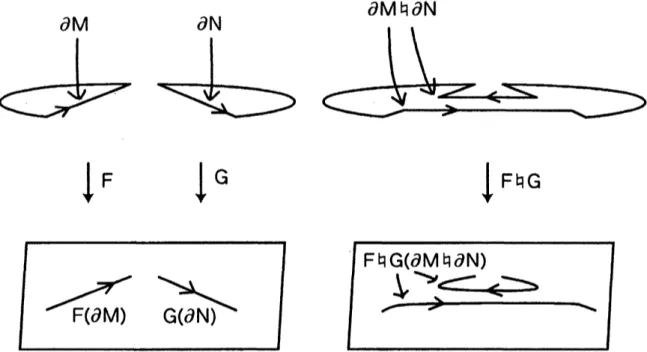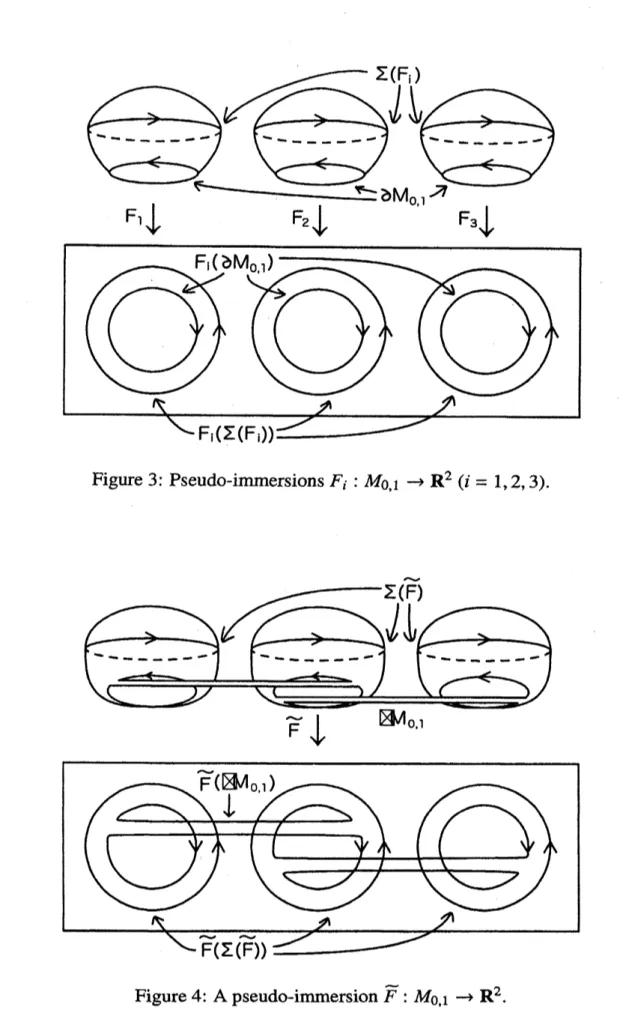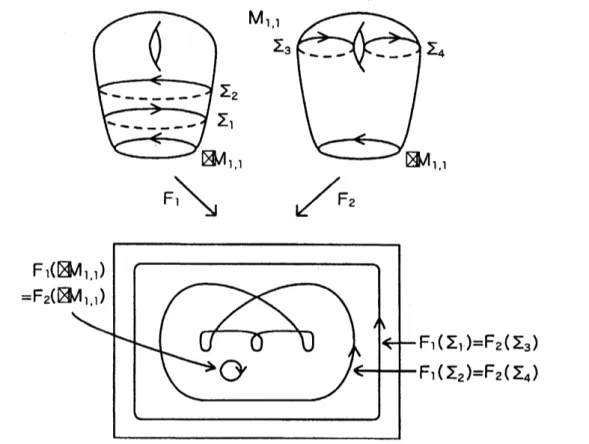On
pseudo-immersions
of
a
surface
into
the
plane
久留米工業高等専門学校
山本 稔 (Minoru Yamamoto)Kurume National
College of Technology1
Introduction
In this
paper,
all manifolds andmaps are
differentiable of class $C^{\infty}$.
Let $M$ bea
compact connected oriented surface with exactly
one
boundary component. Fora
map
$F$ : $Marrow R^{2}$,we
define the set of singularities of $F$as
$\Sigma(F)=(q\in$$M|$rank $dF_{q}<2$}. The
map
$F$ : $Marrow R^{2}$ is calleda
pseudo-immersion if thefollowing
set ofconditions is fulfilled:1. There is
some
open
neighborhood $U$ of$\partial M$, such that $F|U$:
$U+\Rightarrow R^{2}$ isan
orientationpreservingmmersion.
2. In the neighborhood of every singularity $x\in M,$ $F$
can
be represented, inappropriate coordinate systems, by: $y1=x_{1},y2=x_{2}^{2}$
.
We call this type ofsingularity
a
fold
singularity.Note that if $F$
:
$Marrow R^{2}$ isa
pseudo$-\dot{u}$imersion, then $\Sigma(F)$ isa
union ofcirclesand $F|\Sigma(F)$ is
an
immersion. A pseudo-immersionwas
defined by Po\’enaru [6] fora smooth map $F$ : $M^{n}arrow N^{n}$ between n-manifolds. In his definition, he added a
condition for the position of
a
singular set. In thispaper, we
do not consideran
inmersionas a
pseudo-immersion.Let $M$ be
a
compact connected oriented surface with exactlyone
boundarycomponent. The boundary $\partial M$ has the induced orientation of$M$
.
That is, let $n$ betheoutward normalvectorfieldof$\partial M$in$M$then,$\partial M$is orientedbythe unittangent
vector $\tau$ such that the frame $(n,\tau)$ represents the positive orientation of $M$
.
Let$F$
:
$M+\div R^{2}$ bean
orientation preseiving immersion. Thewindingnumber $W(F|\partial)$of therestrictedimmersion$F|\partial M$is the degreeof the
map
$dF(\tau)$ : $\partial M=S^{1}arrow S^{1}$.
By the Poincar\’e-Hopf’stheorem,
we
have(1.1) $W(F|\partial M)=\chi(M)$,
where$\chi(M)$ is the Bulercharacteristic class of$M$
.
Our problem is the following: if $F$
:
$Marrow R^{2}$ isa
pseudo-immersion, thenwhatis the relation between $W(F|\partial),\chi(M)$ and $\#\Sigma(F)$? Here $\#\Sigma(F)$ is the number
ofconnectedcomponents of$\Sigma(F)$
.
Before stating the main theorem,
we
should definean
invariant which relatesDefinition 1.1. Fortwo odd integers$\chi$ and $W$,
we
define (1.2) $m(\chi, W)=\{\begin{array}{ll}\frac{\chi+W}{2}+1 if W>0,\frac{\chi-W}{2} if W<0.\end{array}$Themain theorems
are
the following.Theorem
1.2.
Let $F$:
$Marrow R^{2}$ bea
pseudo-immersionof
a
compact connectedoriented$su\phi ace$ withexactly
one
bounda $y$componentof
theplane.(1.3) $If\chi(M)-W(F|\partial)\equiv 0$ $(mod 4)$, then $\#\Sigma(F)\geq\max\{m(\gamma(M), W(F|\partial)),2)$
.
(1.4) $If\chi(M)-W(F|\partial)\equiv 2$ $(mod 4)$, then $\#\Sigma(F)\geq\max(m(\gamma(M), W(F|\partial)),$$1\}$
.
Theorem 1.3. For any
fixed
odd integer $W$ and odd integer$\chi\leq 1$, there existsa
pseudo-immersion $F$ : $Marrow R^{2}$of
a
compact connectedoriented $su\phi ace$ withexactly
one
boundary componentsuch that(1.5) $\chi(M)=\chi,$ $W(F|\partial)=W$
and such that
(1.6) $\#\Sigma(F)=\max(m(\gamma, W), 2)$ $if\chi-W\equiv 0$ $(mod 4)$
$or$
(1.7) $\#\Sigma(F)=\max(m(\chi, W),$$1\}$ $if\chi-W\equiv 2$ $(mod 4)$
.
Remark 1.4. Conceming Theorems 1.2 and 1.3,
we
note the following.1. Nagase [5] introduced a folding-map. The singularity of
a
folding-map isthe
same
as
that ofa
pseudo-immersion, but itmay
attach the boundary ofa
source
manifold. Nagase proved thatany
immersion of$S^{2}$ into the interiorof
a
homotopy 3-ball $V$extends toa
folding-mapof$D^{3}$ into $V$whosefold-setconsists ofmumally disjoint disks.
2. Bkholm and Larsson [1] defined
an
admissible map. The singularity ofan
adnuissible
map
has not only fold singularities but alsocusp
singularities.For
an
admissiblemap
of $D^{2}$ to the plane, Ekholm and Larsson expressedthe minimal number ofsingular set components
as a
function ofcusps andthe normaldegreeof the image of the boundary
curve
of$D^{2}$.
3. Eliashberg [2] proved the existence of stable
maps
between orientedsur-faces. Similar results of Theorems 1.2 and
1.3
for foldmaps
betweenori-ented closed surfaces
were found
by the author[7].The author would like to thank the organizers Professor Satoshi Koike and
Professor Toshizumi Fukui for organizing and including him in the conference,
2 Preliminaries
In this section, we state
an
importanttooltoprove
Theorem 1.2.Let $F$
:
$Marrow R^{2}$ bea
pseudo-immersion of a compact connected orientedsurface with exactly
one
boundary. Note that $\Sigma(F)\subset M$is two colourable. Here,to
say
thata
l-dimensional submanifold $V\subset M$ is two colourablemeans
that $V$divides $M$into apair of nonempty open surfaces $(B,R)$ of$M$ such that $B\cap R=\emptyset$,
$B\cup R=M\backslash V$andtheclosures $\overline{B}$
and$\overline{R}$
of$B$ and$R$in $M$respectivelyboth contain
V.
For
a
connected component $\gamma\subset\Sigma(F)$,we
define the normal vector field $v_{\gamma}$ of$F(\gamma)$
as
follows: $v_{\gamma}$ points towards the direction in which the number of preimagesof the regular value
near
$F(\gamma)$ decreases. Since $F|\gamma:\gamma\mapsto R^{2}$isan
immersion, $\gamma$isoriented by the tangent vector field $\tau_{\gamma}$ such thatthe frame $(v_{\gamma},dF(\tau_{\gamma}))$represents
the positive orientation of$R^{2}$
.
The winding number $W(F|\gamma)$ is the degree of themap
$dF(\tau_{\gamma})$:
$\gamma=S^{1}arrow S^{1}$ inwhich thesource
hasthe aboveorientation.Let$N(\gamma)=\gamma x[-1,1]$ be
a
tubularneighborhood
of$\gamma\subset\Sigma(F)$ such that$\gamma=$$\gamma x(0\}$ and
we
set$N( \Sigma(F))=\bigcup_{\gamma\subset\Sigma(F)}N(\gamma)$.
Let $E$bea
connectedopen
surface of$M\backslash N(\Sigma(F))$ such that En$N(\gamma)\neq\emptyset$
.
Since$E$is orientableand$F|E$isan
immersion,we
define the orientationof$E$ such that$F|E$ : $E\mapsto R^{2}$isan
orientation preservingimmersion. Each comected component of $\partial E$ has the induced orientation of $E$
.
Note that if$E$ contains $\partial M$, the induced orientations of$\partial M$ from that of$M$ and$E$
are
thesame.
Suppose that$\gamma x\{i\}$$(i=-1 or 1)$belongs to$\partial E$.
Since theorientationof$\gamma x\{i\}$ is the
same as
that of$\gamma x\{0\}$,we
have(2.1) $W(F|\gamma x\{i\})=W(F|\gamma\cross\{0\})$
.
3
Proof
of Theorem
1.2
In this section,
we
prove Theorem 1.2. Let $F$:
$Marrow R^{2}$ bea
pseudo-inmersionof
a
compact connected oriented surface with exactlyone
boundary component. Since $\Sigma(F)\subset M$is twocolourable,we
set $(B,R)$as a
two colourdecompositionofthe pair $(M, \Sigma(F))$ such that $\partial\overline{B}$
contains $\partial M$. By (3.1) and the factthat $\Sigma(F)$ is
a
closed l-dimensional submanifold,
we
have(3.1) $\chi(\overline{B})=W(\Sigma(F))+W(F|\partial)$, (3.2) $\chi(\overline{R})=W(\Sigma(F))$, (3.3) $\chi(M)=\chi(\overline{B})+\chi(\overline{R})$
.
Therefore,we
have (3.4) $W(F|\partial)=\chi(M)-2W(\Sigma(F))$, (3.5) $W(F|\partial)=\chi(\overline{B})-\chi(\overline{R})$.
Proposition 3.1. The windingnumber $W(F|\partial)$
of
the restricted immersion $F|\partial M$isodd.
Suppose that the number ofconnected components of$\overline{B}$
(resp. $\overline{R}$
) is $n_{B}$ (resp.
$n_{R})$,the
sum
of thegenusesof eachconnectedcomponent of$B$(resp.$R$)is $gB$ (resp.$gR)$ and the
genus
of $M$ is $g$.
Since the number of boundary components of $B$ isequalto $\#\Sigma(F)+1$ and the numberofboundary components of$R$ is equalto$\#\Sigma(F)$,
(3.3) and (3.5)
are
writtenas;(3.6) $\chi(M)=2n_{B}-2gB+2n_{R}-2gR^{-2\#\Sigma(F)-\iota}$,
(3.7) $W(F|\partial)=2n_{B}-2gB^{-2n_{R}}+2gR^{-\iota}$
.
Thus,
we
have(3.8) $\chi(M)-W(F|\partial)=4n_{R}-4gR-2\#\Sigma(F)$.
By this equation,
we
have the following.Proposition
3.2.
$If\chi(M)-W(F|\partial)\equiv 0(mod 4)$, then the numberof
singularsetcomponents $\#\Sigma(F)$ is
even.
$If\chi(M)-W(F|\partial)\equiv 2(mod 4)$, then the numberof
singularset components $\#\Sigma(F)$ is odd.
Suppose that $W(F|\partial)>0$
.
Thenby (3.8),we
have$\#\Sigma(F)=\frac{-\chi(M)+W(F|\partial)}{2}+2n_{R}-2gR$
(3.9) $\geq\frac{-\chi(M)+W(F|\partial)}{2}+2-2g$
$= \frac{\chi(M)+W(F|\partial)}{2}+1$
.
Here, $g$is the
genus
of$M$.Suppose that $W(F|\partial)<0$. Theninstead of(3.8),
we
have(3.10) $\chi(M)+W(F|\partial)=4n_{B}-4gB-2\#\Sigma(F)-2$
.
Therefore,
$\#\Sigma(F)=\frac{-\chi(M)-W(F|\partial)}{2}+2n_{B}-2_{9B}-1$
(3.11) $\geq\frac{-\chi(M)-W(F|\partial)}{2}+2-2g-1$
$= \frac{\chi(M)-W(F|\partial)}{2}$
.
Combining(3.9), (3.11)andProposition3.2,
we
havethe desired inequalities. This completes the proof of Theorem 1.2.4
Examples
To
prove
Theorem 1.3, it isnecessary
to constructthe desired pseudo-immersionsconcretely byusingFrancis’ theorem[4]. Insteadofgiving such pseudo-immersions
in all the cases,in this section, we givetypical.examples.
4.1
The
case
of$\chi=1-2g$ and $W=2g-1$Let $M_{g}$ be
a
closed oriented surface of thegenus
$g$ and $M_{g,1}=M_{g}\backslash D^{2}$.
It isobvious that$\chi(M_{g,1})=1-2g$
.
$\ln$this subsection,we
constmcta
pseudo-immersion$F$
:
$M_{g,1}arrow R^{2}$such that $W(F|\partial)=2g-1$ and $\#\Sigma(F)=m(1-2g,2g-1)=1$.Let $N(\partial M_{g,1})=\partial M_{g,1}x[-1,0]$ be
a
tubularneighborhood of$\partial M_{g,1}$ such that$\partial M_{g,1}=\partial M_{g,1}\cross(0\}$
.
Let $F_{1}$:
$M_{g,1}\backslash N(\partial M_{g,1})+\div R^{2}$ bean
orientationpreservingimmersion and $F_{2}$
:
$N(\partial M_{g,1})*\div R^{2}$an
orientation preserving immersion suchthat $F_{1}|\partial M_{g,1}\cross(-1\}=F_{2}|\partial M_{g,1}\cross(-1\}$
.
Then, by attaching $F_{1}$ and $F_{2}$ and bychangingthe orientationof$\overline{M_{g,1}\backslash N(\partial M_{g,1})}$,
we
havea
desiredpseudo-immersion $F=F_{1}\cup F_{2}$:
$M_{g,1}arrow R^{2}$ such that $W(F|\partial)=2g-1,$ $\Sigma(F)=\partial M_{g,1}\cross(-1\}$. SeeFigure 1.
Figure 1: The
cases
of$g=0,1$.
4.2
The
case
of
$\chi=1$and
$W=-2n+1$Let $n$ be
a
positive integer. In this subsection,we
constructa
pseudo-immersion$\tilde{F}$
:
$M_{0,1}arrow R^{2}$ suchthat $W(\tilde{F}|\partial)=-2n+1$ and $\#\Sigma(F)=m(1, -2n+1)=n$
.
Beforeconstructing the desired pseudo-immersion,
we
willexplaina
boundaryconnected
sum
of two pseudo-immersions. Let $F$:
$Marrow R^{2}$ and $G$:
$Narrow R^{2}$ betwoclosed intervals$I_{a}=I_{b}=[0,1]$ and$H$
:
$I_{a}\cross I_{b}arrow R^{2}$an
orientationpreservingembedding. Let $i_{M}$ : $(0\}\cross l_{b}arrow\partial M$ and $i_{N}$
:
$\{1\}\cross l_{b}arrow\partial N$ be orientationreversing embeddings such that $F\circ i_{M}=G\circ i_{N}=H$
.
Then $F \cup\iota_{M}H\bigcup_{i_{N}}G$ :$M U_{i_{M}}I_{a}\cross I_{b}\bigcup_{i_{N}}Narrow R^{2}$is
a
pseudo-immersion. We denote $F \bigcup_{i_{M}}HU_{i_{N}}G$as
$F\# G$ and $M \bigcup_{i_{M}}I_{a}xI_{b}\bigcup_{i_{N}}N$
as
$M\# N$andwe
call$F\# G$a
boundary connectedsum
of$F$ and$G$. Note that $W(F\# G|\partial)=W(F|\partial)+W(G|\partial)-1$. See Figure 2.
$\partial N$
$\downarrow F$ $\downarrow G$
$\partial M\#\partial N$
$\downarrow F\#G$
Figure 2: Aboundary connected
sum
oftwopseudo-immersions.Let $F_{i}$
:
$M_{0,1}arrow R^{2}(i=1,2, \ldots,n)$ bea
copy
of the pseudo-immersionwhich is constructed in Subsection 4.1. We take
a
boundary connectedsum
of$F_{1},F_{2},$ $\ldots,F_{n}$. We set $\tilde{F}=F_{1}\# F_{2}\#\cdots$
in
$F_{n}$ andwe
have $M_{0.1}\# M_{0,1}\#\cdots\# M_{0,1}=$$M_{0,1}$. Because $W(\overline{F}|\partial)=-n-(n-1)=-2n+1$ and $\#\Sigma(\tilde{F})=n$, the
pseudo-immersion $\tilde{F}$
:
$M_{0,1}arrow R^{2}$ is the desired
one.
See Figures 3 and 4 in thecase
$n=3$.
5
Supplement
5.1
Position
of thesingular
set
In thissection,
we
remarkon
thepositionsof thesingularsetofa
pseudo-immersion$F:Marrow R^{2}$.
Proposition
5.1.
Let $F_{1}$ and $F_{2}$:
$Marrow R^{2}$ be two pseudo-immersionsof
acompact connected oriented
suiface
with exactlyone
boundary component.If
$\Sigma(F_{1})=\Sigma(F_{2})=1$, then an orientation$preser\nu ing$ diffeomorphism $\Phi$
:
$Marrow M$Figure 3: Pseudo-immersions$F_{i}$
:
$M_{0,1}arrow R^{2}(i=1,2,3)$.
Figure 4: A pseudo-immersion$\tilde{F}$
:
This proposition is obvious. Ifthe number ofsingular set components is
more
than one, the above proposition is not true. For example, let $\Sigma_{1}$ and $\Sigma_{2}$ be twosimpleclosed
curves
in$M_{1,1}$ that splits $M_{1,1}$ into three connected surfaces. Two ofthem
are
annuli and the other isone
puncturedtoms. Let $\Sigma_{3}$ and$\Sigma_{4}$ be two simpleclosed
curves
in $M_{1.1}$ that splits $M_{1,1}$into
two connected surfaces. Both of themare
annuli. By usingFrancis’ theorem [4],we
have twopseudo-immersions $F_{1}$ and$F_{2}$
:
$M_{1,1}arrow R^{2}$ such that $\Sigma(F_{1})=\Sigma_{1}\cup\Sigma_{2},$ $\Sigma(F_{2})=\Sigma_{3}\cup\Sigma_{4},$ $F_{1}(\Sigma_{1})=F_{2}(\Sigma_{3})$,$F_{1}(\Sigma_{2})=F_{2}(\Sigma_{4})F_{1}(\partial M_{1,1})=F_{2}(\partial M_{1,1})$ and $W(F_{1}|\partial)=W(F_{2}|\partial)=-1$. See
Figure 5.
Figure 5: Twopseudo-immmersions $F_{1}$ and $F_{2}$ : $M_{1,1}arrow R^{2}$ suchthat $F_{1}(\Sigma(F_{1}))=$
$F_{2}(\Sigma(F_{2}))$.
5.2
Image of the boundary ofa
pseudo-immersionIn this subsection,
we
statetheexistence ofa
pseudo-immersionsuchthat the givenplane
curve
is the image of the boundaryofthemap.
Applying Eliashberg andFrancis’ theorem [2, 3],
we
have thefollowingtheo-rem.
Theorem 5.2. Let $M$ be
a
compact connected orientedsuiface
with exactlyone
odd, then there exists
a
pseudo-immersion $F$:
$Marrow R^{2}$ such that(5.1) $F|\partial M=f$
and
(5.2) $\#\Sigma(F)=\max\{m(\chi(M), W(f)), 2\}$ $if\chi(M)-W(f)\equiv 0$ $(mod 4)$
$or$
(5.3) $\#\Sigma(F)=\max(m(\chi(M), W(f), 1)$ $if\chi(M)-W(f)\equiv 2$ $(mod 4)$
.
Thedetails ofTheorem5.2
are
in [8].References
[1] T. Ekholm and O. Larsson, Minimizing singularities
of
generic plane diskswith immersedboundaries, Ark. Mat. 43 (2005),
347-364.
[2] Y. Eliashberg, On singularities
of
folding type, Math. USSR Izv. 4 (1970),1119-1134.
[3] G. K. Francis, The
folded
ribbon theorem. A contribution to the studyof
im-mersedcircles, Trans. Amer. Math. Soc. 141 (1969), 271-303.
[4] G. K. Francis, Assembling compact Riemann
suifaces
with $gi\nu en$ boundarycurves
and branchpointson
the sphere, Illinois J. Math.20
(1976),198-217.
[5] T.Nagase, On the singularities
of
mapsfrom the 3-ball intoa
homotopy3-ball,Topology and Computer Science (1987),
29-41.
[6] V. Po\’enaru, On regularhomotopy in codimension 1, Ann. ofMath.
83
(1966),257-265.
[7] M. Yamamoto, The number
of
singularsetcomponentsoffold
maps betweenoriented
sutaces,
(2007),toappear
inHouston Joumalof Mathematics.[8] M. Yamamoto, The number
offold
singularitiesof
pseudo-immersionsof
ori-entedsu
ffaces, (2008), preprint.DEPARTMENTOF SCIENCE,KURUME NATIONAL COLLEGEOFTECHNOLOGY,
KOMORINO 1-1-1,KURUMECITY, FUKUOKA830-8555, JAPAN



